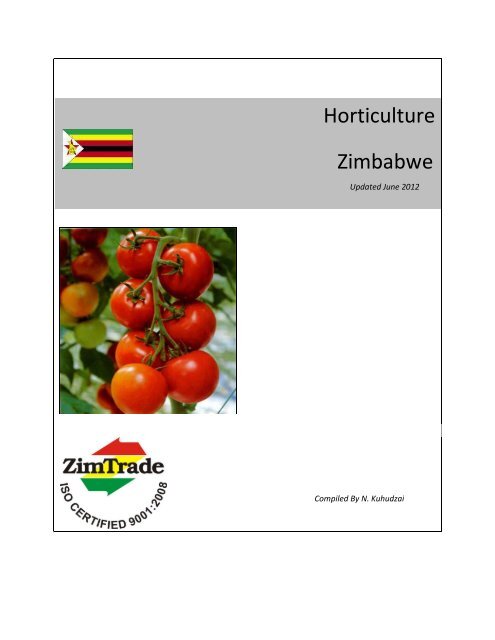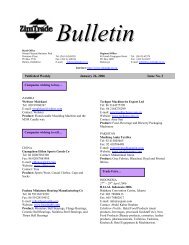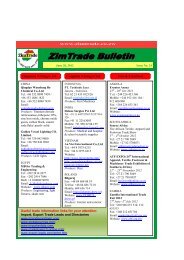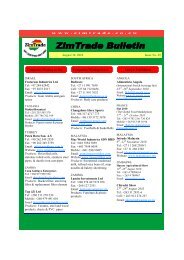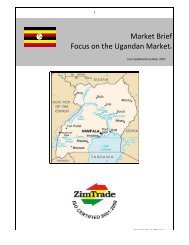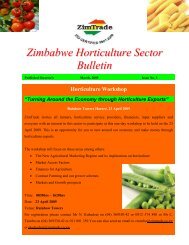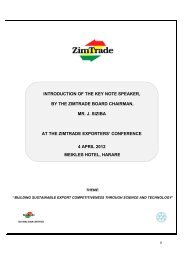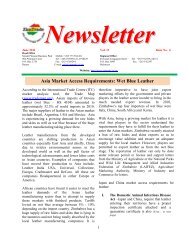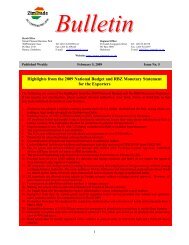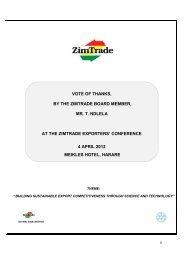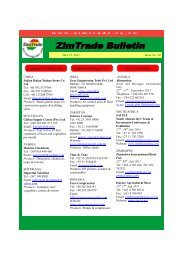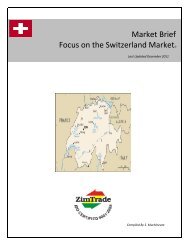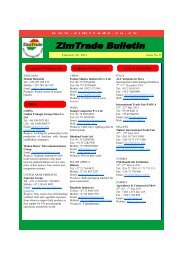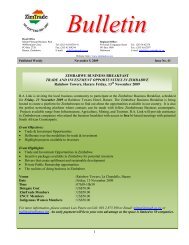Horticulture Zimbabwe - ZimTrade
Horticulture Zimbabwe - ZimTrade
Horticulture Zimbabwe - ZimTrade
You also want an ePaper? Increase the reach of your titles
YUMPU automatically turns print PDFs into web optimized ePapers that Google loves.
<strong>Horticulture</strong><strong>Zimbabwe</strong>Updated June 2012Compiled By N. Kuhudzai
CONTENTS1. Definition of the sector• Description• Coverage2. Overview of the <strong>Zimbabwe</strong> agricultural sector developmental situation3. Major players4. Production –supply capacity5. Major export markets6. Export-volumes, growth percentage.7. Challenges faced by the sector and sector needs analysis8. Programme of intervention/ action9. Address of sector associations
Definition of the sectorDescriptionThe sector, like the broad agriculture sector, is dualistic in nature. There are largecommercial farms and pack houses and also small-scale producers. Most of the smallscalefarmers become out-growers for the established pack houses and exporters whowield the export markets.CoverageThe horticulture sector covers all the products as classified under HS 06, 07, 08 andparts of HS12. That is flowers, vegetables and fruits.Overview of the <strong>Zimbabwe</strong> agricultural sector developmental situationThe <strong>Zimbabwe</strong>an agricultural sector is dualistic, comprising large and small scalefarmers.Until recently, the large scale sector comprised about 4000 large scale farmerswith sophisticated production systems and occupying 11 million hectares of landprimarily located in the areas of high agricultural and economic potential. The communaland small-holder farmers on the other hand occupied areas of lower natural potential inagriculture in terms of rainfall, soils and water for irrigation. Generally, the communalfarmers produce mainly for home consumption while the large-scale farmers producefor commercial purposes. As a result, while the main agricultural produce from thecommunal or small holder farmers include the staple maize, groundnuts, cotton, beans,vegetables, meat and milk, commercial farmers concentrate on cash crops such astobacco, horticultural products particularly cut-flowers, coffee, maize, groundnuts,sorghum, sugar, soybeans, sunflower, cattle for slaughter, pigs, goats and sheep.Major playersMajor Pack houses/exporters Selby Fresh Trade Natfresh RollexMajor wholesalers Interfresh Harare Produce Sales Manica Produce Freshpro FAVCO
Major retailersOK supermarketTM supermarketSparBon MarcheFood WorldProduction –supply capacityOutput has declined over the years especially after 2000 when most large scalemechanized producers were removed from the farms.Major Export MarketsFlowers 85%- Netherlands auctions (from hence Germany, UK, USA, France, Italy etc)Fresh Vegetables 90%- UK, South Africa, Zambia, NamibiaFruits 80%- UK, South Africa<strong>Zimbabwe</strong> Horticultural Exports from 1986 to 2010Year Mass in Tonnes Estimated Value in US$ (thousands)Flowers Produce Citrus Flowers Produce Citrus Total1986 338 396 2272 1555 1188 772 35151987 593 610 5026 2728 1830 1709 62671988 1326 748 7352 6100 2244 2500 108441989 2411 1413 8002 11091 4239 2668 179981990 2872 2823 8780 13211 8469 2985 246651991 3722 4215 6300 17121 12645 2142 319081992 4758 4354 8930 21885 13063 3036 379841993 5206 3999 9000 23948 11996 3060 390041994 5770 5202 15000 26541 15607 5100 472481995 9095 8989 20000 41839 26967 6800 756061996 11630 10202 24000 53497 30605 8160 922621997 13832 9792 30000 63628 29377 10200 1032051998 14729 10948 30000 67753 32844 10200 1107971999 18411 14232 45000 84692 42697 15300 142689
2000 17857 10217 44289 81323 30346 13561 1252302001 21749 9955 45840 78297 26341 14510 1191482002 22801 10950 48132 86189 23983 14330 1245022003 20171 10236 47767 72616 25179 14221 1120162004 16271 7277 34228 58578 18193 11637 884082005 14327 4553 26311 51576 11383 8946 719052006 12327 3631 25850 45106 9078 7985 621692007 10420 3445 24730 36470 8640 7591 527012008 9535 3240 23500 32895 8100 7010 480552009 7670 2800 23670 26078 6810 7260 401482010 7500 2753 2400 24375 6600 8200 39175Source: HPCExport trend250000<strong>Horticulture</strong> Export Trend200000Value in US$1500001000005000001986198719881989199019911992199319941995199619971998199920002001200220032004200520062007200820092010<strong>Horticulture</strong> Export Trend
Growth percentageIn terms of export volumes, the sector has declined an average of 21% per year since1986 based on the above table.<strong>Horticulture</strong>’s contribution to <strong>Zimbabwe</strong> exports in comparison to other sectorsin 2008Source: RBZThe chart above shows horticulture’s contribution to the country’s exports standing at2% in 2008 from 13% in 2007.For the period 1 January 2008 to 31 December 2008 total shipments under thehorticulture sub-sector amounted to, US$24,646,949 compared to US$27,703,307 in2007, representing a decline of 11,0%. The main reasons for the sustained decline aregiven as the challenges below.Contribution to GDPAgriculture contributed about 17% of <strong>Zimbabwe</strong>’s GDP in 2011.
Challenges faced by the sector and needs analysisChallengePower outages- this grossly affects freshproduce exports which require certaintemperatures to be maintained and alsoaffects irrigation of the crops.Labour shortages- due to low pay farmworkers are opting for gold/diamondpanning as a source of livelihood.Lack of transport or prohibitive cost of hiringtransport to markets for small scale farmersLack of a national policy specificallytargeting development of horticulture.Efforts have been made to come up withthe National Horticultural LiaisonCommittee, however it needs funding andgovernment buy-in at the highest levelpossible.Very high start up costs especially for newfarmers (infrastructure like greenhouses,cold rooms and working capital).Political influence and mistrust. Mostforeign buyers who used to buy from<strong>Zimbabwe</strong> do not want to buy from the newfarmers partly for political convictions andalso fear of lack of supply consistency.NeedNeed to solve the national powerproblem especially as it affectsagriculture. There is need forinvestment in electricity generation.There is need to pay farm workersrealistic salaries.It would help to have government or aninstitutional investor willing to secure afleet of vehicles that can be leased tofarmers a t concessionary ratesThere is need for government to driverecovery of the sector by formulatingpolicies that are horticulture specificand empower organizations like theHPC. Partnerships can also be forgedwith the private sector.Need for massive investment ininfrastructure. There is dire need forour banking sector to extend support tofarmers for infrastructure development.Need to rebrand <strong>Zimbabwe</strong> as acountry and correct misconceptionsabout the land reform, politics andeconomics of the country.Dilapidated irrigation infrastructure,particularly in communal areasHighly technical requiring specialized skillsand labour intensive at the same timeStringentNeed for rehabilitation of all irrigationinfrastructure and seek investment innew onesThere is need to capacity build smallscale farmers on the expertise requiredin handling fresh and highly perishableproducephyto-sanitary Need to develop a local standard
demands/measures on quality, food safetyand hygiene especially from Europe.Logistical problems because of distancefrom market. The biggest market for ourhorticulture produce is Europe.<strong>Horticulture</strong> exports are prone to pricefluctuations because of global supply anddemand factors.Sophiscated markets. The EU market,which is the biggest, is controlled by Cartelswho determine the prices and who buysfrom whom and who sells to whom. Ourproducers are price takers hence make thinprofits. These Cartels mainly buy for resale.In order to sell in these markets especiallyNetherlands you have to know someone i.e.have an agent. This does not always workto our advantage. Revenue is lost going thecartels/agents route.which can be benchmarked to theGlobalGap standardNeed to establish air cargo hub inHarare and have national cargo carrierthat can fly directly to Europe.Need to capacity build farmers on pricetrends and how they can benefit fromthemThere is need to build relationshipswith the markets. It is important tosupport farmers on excursions to targetmarkets were they can now obtain vitalcontacts and build businessrelationships. Were possible farmerscan also form their own producercartels to tackle these markets.Programme of intervention/ action• Train farmers on the importance of quality• Obtain project proposals from sector members and market these to potentialpartners.• Assist farmers and companies to participate in local and regional fairs• Visit companies to understand their progress and challenges alike so as to giverelevant advice.• Send out market opportunities to sector members.Address of sector associations<strong>Horticulture</strong> Promotion Council23 Sloane StreetHighlandsHarare


